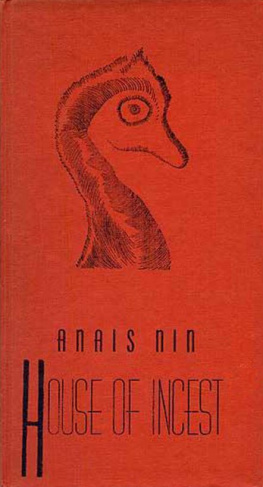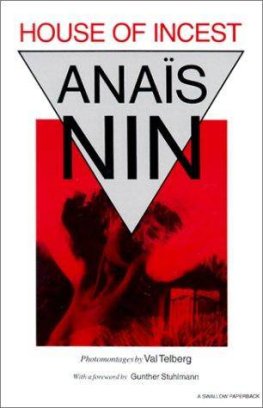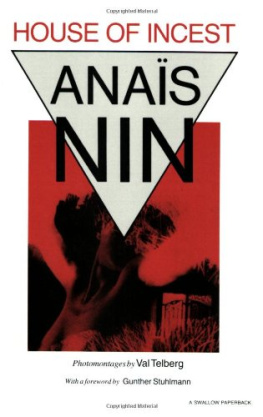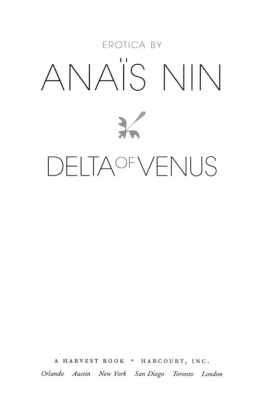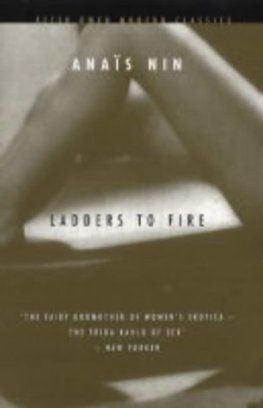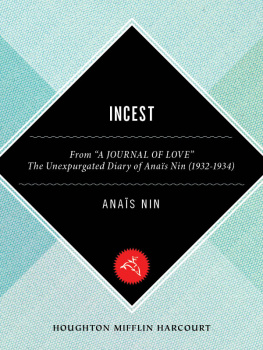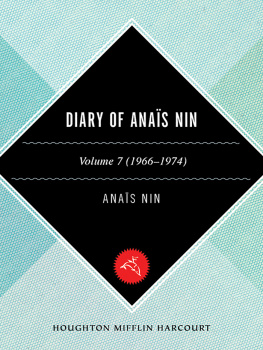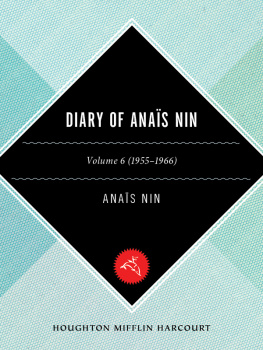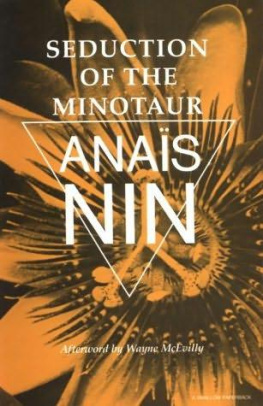A Harvest Book
The Swallow Press and
Harcourt Brace & Company
San Diego New York London
Copyright 1967 by Anas Nin
Preface copyright 1967 by Gunther Stuhlmann
All rights reserved.
No part of this publication may be
reproduced or transmitted in any form or by any means,
electronic or mechanical, including photocopy, recording,
or any information storage and retrieval system,
without permission in writing
from the publisher.
Requests for permission to make copies
of any part of the work should be mailed to
Permissions Department,
Harcourt Brace & Company, 6277 Sea Harbor Drive,
Orlando, Florida 32887-6777
Library of Congress Catalog Card Number 66-12917
ISBN 0-15-626026-3 (pbk)
Printed in the United States of America
S T U V W
Preface
When Anas Nin's Diary: 19311934 appeared in the spring of 1966, Karl Shapiro, the Pulitzer Prize-winning poet, wrote in Book Week: "For a generation the literary world on both sides of the Atlantic has lived with the rumor of an extraordinary diary. Earlier readers of the manuscript discussed it in breathtaking superlatives as a work that would take its place with the great revelations of literature. A significant section of this diary is at last in print and it appears that the great claims made for it are justified."
Indeed, the reception of the first volume showed that Miss Nin's enormous lifework, which for various reasons may defy publication in its entirety, did not lose its impact and uniqueness in the inevitable fragmentation of partial presentation. For even the sizable segment of this first volume, covering a little over three years in Miss Nin's life, encompassed merely some 600 pages of the 15,000-page transcript of the original diary volumes, which today fill two four-drawer filing cabinets in a Brooklyn bank vault.
To choose from a cohesive, organically developing text like that of the diary, with its weaving and reweaving of time and incident, its natural gaps and duplications, its gradual maturing, is always a precarious undertaking. The author's own initial selectivity in writing her diary is re-enacted, for the second time, in the editorial process. And the original diary itself, in all its fullness, after all is merely a reflection, a refraction, of the totality of the author. It is not the full, rounded, day-to-day Anas Nin portrayed in place and time with an eye toward presenting herself to the world. In her unabashed, sometimes unflattering exposure of the inner person, of her spontaneous reaction to people, events and ideas, Miss Nin takes us into a confidence undisguised by the art of the writer. But it is her very gift and skill as a writer, even in her early years, that breathes vibrant life into the pages of the diary, that gives even to the fragment the sweep and impact of a unified whole. Wherever we pick up the diary we are caught, as it were, in the novel of her life, a novel that moves instinctively, logically, like a dream, with its own rhythms, tensions, actions and counter-actions.
The first volume opened at the time Miss Nin was about to make her literary debut with a brief, passionate study of D. H. Lawrence. She was then living, with her family, in an ancient, shuttered house in the sleepy village of Louveciennes, on the outskirts of Paris. But the surface calm of this rural settingafter the glamorous turmoil of Miss Nin's Catholic childhood in Europe and the trying years of her exiled youth in the United Stateswas soon shattered by her growing, intense involvement with a host of artists and intellectuals, foremost among them the then unknown "gangster-author," Henry Miller, his remarkable wife, June, and the fevered surrealist poet, Antonin Artaud. Pressed into many self-imposed, multilateral roles as artist, wife, sister, daughter, caretaker, muse, confidante and glamour-girl, she found herself trapped between the polished vacuity of "society" and the abrasive freedom of "Bohemia." Pursued by an often excruciatingly painful self-awareness, and haunted by the elegant, egotistical shadow of her father, the Spanish composer-pianist Joaquin Nin, who had deserted the family in her childhood, she tried to understand and untangle through analysis the many strands of her personality. But neither Dr. Ren Allendy, the founder of the French Psychoanalytical Society, nor Sigmund Freud's banished pupil, Dr. Otto Rank, with whom she explored both the role and the creative possibilities of woman in the modern world, could provide her with more than partial answers. In her refuge, the diary, which she carried with her like a magic amulet, she analyzed the analysts. In November 1934, at the end of Volume I, two months after Henry Miller, with her steadfast support, had published his first book, Tropic of Cancer, she was about to leave Paris. Dr. Rank, driven by the Depression to shift his practice to New York, had urgently called her to join him for a time in his work in the United States.
The present volume continues the diary directly with Miss Nin's arrival in New York. Like the first, it is a self-contained unit, bounded by events which, both externally and internally, mark significant changes in Miss Nin's life and provide a natural framework within the over-all flow of the diary.
The text of this volume represents about half of the original diary manuscriptsvolumes 40 to 60covering the period from 1934 to 1939. Certain people, including Miss Nin's husband and members of her family, again had to be eliminated. The names of some of her analytical patients had to be changed or omitted, and the dates provided by the editor merely summarize the specific anddue to Miss Nin's later reflection on a previous eventsometimes confusing dates in the originals.
If there is a difference, a slow shift in emphasis, between this and the previous volume, it is, perhaps, a move away from introspection, a strengthening of Miss Nin's stance82 vis--vis the outside world. To be sure, Miss Nin's critical lens still focuses sharply and candidly upon herself: "What I like best about myself," she writes, "is my audacity, my courage. The ways I have found to be true to myself without causing too much pain or damage.... What I hate so much is my vanity, my need to shine, my need of applause and my sentimentality. I would like to be harder. I cannot make a joke, make fun of anyone, without feeling regrets." But her need, the confessional function of the diary, is changing. She has slain the ghost of her father, though she still seems to be instinctively looking for a "leader," a father figure. Her attitude toward Henry Miller and his Bohemian friends is undergoing a change. She is less tolerant of people's eccentricities, of the waste of talent. Her involvements with her own work, with Gonzalo, the wild Indian revolutionary, and his wilting wife, Helba, with the young Lawrence Durrell, acquire a new dimension, a new solidity. She still "cannot stay quietly rooted anywhere because of the many sides of myself constantly sprouting, the layers of latent mysteries, the things I am not yet." She still is caught in the web of her different personae, but the world, somehow, is becoming more real, more tangible, the choices clearer.
"The diary," she writes in the late 1930s, "was once a disease. I do not take it up now for the same reasons. Before it was because I was lonely, or because I did not know how to communicate with others. I needed the communion. Now it is to write, not for solace but for the pleasure of describing others, out of abundance."
Her inborn technique, the selective eye of the earlier diary, which gave such urgent immediacy to the previous volume, is becoming more and more a conscious artistic principle: the captured moment of intense emotional reality. Her "portraits," she explains, were done only "at the moment when a person was important to me. The person rises and sinks, appears and vanishes only in relation to me." The external narrative, the merely descriptive, remains fragmentary. "It's like a statue without arm or hand, unearthed, and having to be deciphered, divined." Thus, when she arrives in New York, the characters who so intensely peopled her Paris life fade before the onrush of new situations, new entanglements. Her diary bulges with the stories of her analytical patients. When she returns to France, having been forced to choose between the analytical profession and her need to create as a writer, the same process involves her New York friends. They flash onto the diary screen only at the heightened moments of concern, of actual, emotional contact.
Next page

